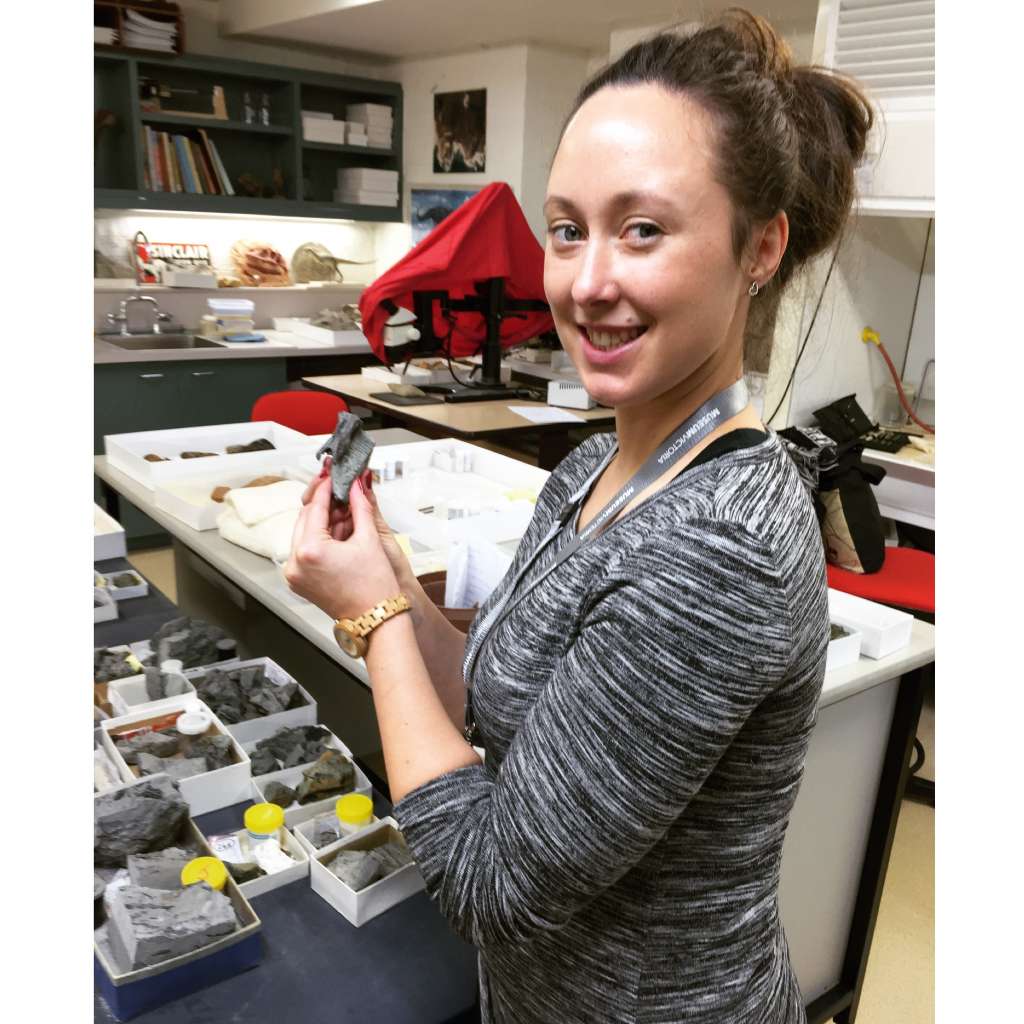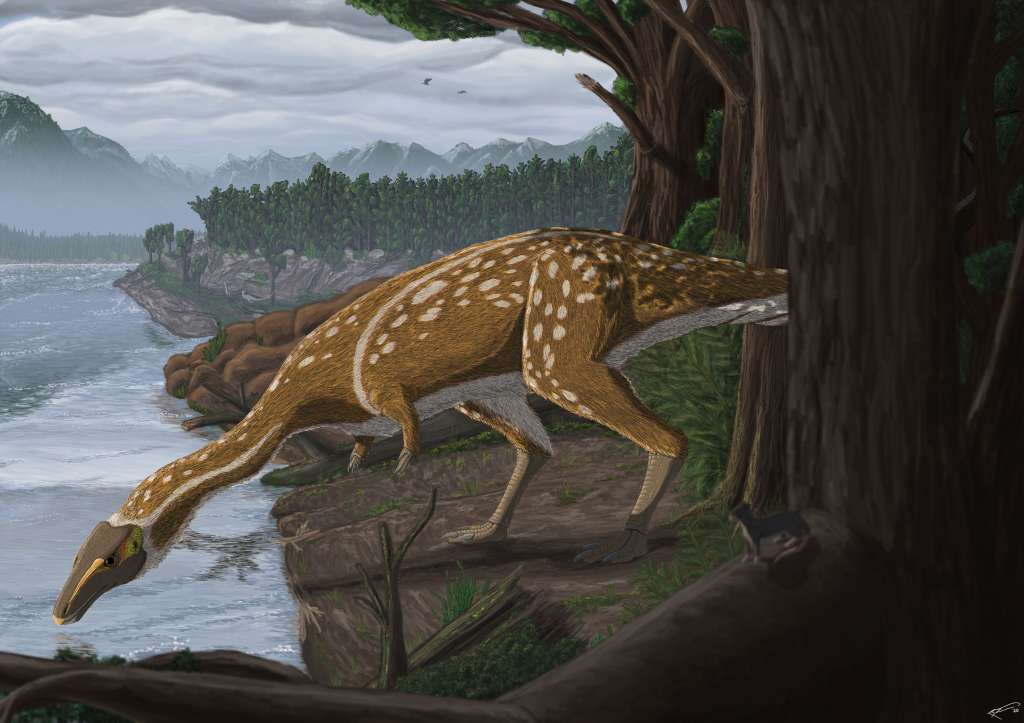A series of lucky events and some quick thinking on behalf of paleontologists at Swinburne University of Technology have helped unearth Australia’s very first group of elaphrosaurs, a type of toothless dinosaur that lived around 107 to 110 million years ago.
The discovery hails not only the first elaphrosaur from Australia but only the second to be found anywhere in the world that lived during the Cretaceous period, shattering the previous hypothesis that these creatures thrived in the Jurassic and disappeared thereafter.
Swinburne’s Dr Stephen Poropat and Adele Pentland uncovered this new Australian dinosaur by stumbling across an incorrectly identified vertebra in the collections at Melbourne Museum around four years after it had been dug up by Dinosaur Dreaming volunteer Jessica Parker near Cape Otway on Victoria’s coast.
A logical step-by-step elimination of the type of dinosaur that lay behind the vertebra and an in-depth analysis of the fossil itself led Poropat and Pentland to determine that the vertebra was in fact from a previously undiscovered type of elaphrosaur with the study1 now published in the Gondwana Research journal.
A misunderstood dinosaur
Elaphrosaurines were a type of dinosaur that ran on two legs, had a long neck, short arms and were likely to have a beaked but toothless skull as adults. They are part of a group of dinosaurs known as theropods, which had hollow bones and three-toed feet, and which were found throughout the Triassic, Jurassic and Cretaceous periods.
There presently have been only a small number of elaphrosaur fossils unearthed across the globe, including Elaphrosaurus bambergi from Tanzania, Limusaurus inextricabilis from China, and more recently Huinculsaurus montesi from Argentina.
Historically, elaphrosaurines had been misclassified as other types of theropods with the Tanzanian Elaphrosaurus originally believed to be an ornithomimosaur, also known as an ostrich dinosaur, Pentland told Lab Down Under.
These factors led to a dearth of knowledge about elaphrosaurs which both Poropat and Pentland had to work through to correctly identify the Melbourne Museum vertebra. Correcting similar misclassification of already uncovered dinosaur fossils could help fill these gaps, Pentland said.
“There’s every possibility that more elaphrosaurines will be found in coming years, not from the discovery of new specimens per se, but by re-examining old specimens and looking at them with fresh eyes.”

Image 1: Parker with the vertebra she discovered at Melbourne Museum.
Living in a lush polar environment
The newly discovered elaphrosaur lived in the Cretaceous period when the area now known as Victoria was located within the Antarctic Circle. At the time, Australia, Antarctica and South America were all joined together as one landmass.
“Given that Victoria was situated near the South Pole at this time, there would have been multi-month periods of darkness and light each year. However, despite the high latitude, the flora was diverse and abundant,” Poropat said.
Because these landmasses were joined, the circumpolar currents of today, which prevent warm equatorial waters from reaching Antarctica, did not exist 110 million years ago. Back then, there was also a greater amount of carbon dioxide in the atmosphere.
As a result of these two factors, the polar regions were a lot warmer back then than they are today.
“The simple point is trees and plants were able to grow much closer to each pole than they are today because the poles were warmer,” Poropat said.
The newly discovered elaphrosaur would have lived among a wide variety of plants, including conifers, flowering plants, ferns, cycads, horsetails and ginkgos.
What we can tell from a single bone
From the vertebra, which was around five centimetres long, Poropat and Pentland determined that the elaphrosaur was about two metres long, making it a smaller member of the group.
However with only the single bone, it has been difficult to ascertain whether this newly discovered dinosaur was a carnivore or herbivore, i.e. whether it ate meat or plants.
This is because gaps in the current scientific knowledge made it “a really difficult one to pin down”, Poropat said.
Out of all the elaphrosaurs previously discovered, only one has been found with a skull, Limusaurus inextricabilis. Even then, evidence suggested that Limusaurus actually changed its diet over time, with juveniles having teeth while the adults had beaks made out of keratin, he said.
Ultimately an assumption about the diet of this Australian elaphrosaur had to be made by looking at the wider theropod group.
“Most of the beaked theropods that we’ve found so far, they seem to be primarily herbivorous and we’d probably assume the same for this elaphrosaur,” Poropat said.
Fortunately, another dinosaur find that occurred this earlier year in Argentina2 also shored up the conclusion that the Australian vertebra was an elaphrosaur. While previously discovered elaphrosaur fossils had come from the Jurassic period, both the Australian specimen and the Argentinian Huinculsaurus montesi fossil were from the Cretaceous.
“It’s just been assumed, because there was no Cretaceous fossil record of them until this year, that at the end of the Jurassic they just disappeared,” Dr Poropat said.
Both the Australian and Argentinian findings confirm this theropod group survived much later into the Cretaceous than previously thought.
The not-so-usual suspects
As for how the pair determined the bone was an elaphrosaur, this required some logical deductions and eliminations.
Pentland, who specialises in pterosaurs (flying reptiles) first came across the vertebra while looking through the collections at Melbourne Museum. Several years before, collections manager Dave Pickering had identified the specimen as likely being from a pterosaur, which is why it initially caught Pentland’s eye.
However, upon looking closer at the fossil, Pentland realised it had been misidentified.
“So pterosaur vertebra are always procoelous — which basically means that the head end of the centrum is concave and the tail end is convex — whereas this vertebra has two concave surfaces,” she told Lab Down Under.
From the fossil’s characteristics, Poropat immediately ruled out sauropods and ornithischian dinosaurs. After settling upon theropods, he then crossed out a number of suspects based on the age of the fossil and where it had been found. For instance, Coelophysis vertebra looked similar but were a much older type of dinosaur from the Triassic. On the other hand, while ornithomimosaur vertebra looked the same, none had been conclusively discovered in the Southern Hemisphere, let alone Australia, before.
“The simple fact of the matter is the elaphrosaurs have historically been confused with ornithomimosaurs. And so I thought that’s the next logical step. Let’s go and have a look at Elaphrosaurus because that’s from Africa, from the Jurassic, so not as far removed in time, and when we went to the most recent studies on that animal, sure enough the vertebra looked almost exactly the same,” Poropat said.
Future finds and present discoveries
The work done on the vertebra itself has been fairly exhaustive, including a phylogenetic analysis, which examined the evolutionary relationships between this elaphrosaur and other dinosaurs. From this data, Poropat and Pentland could work out the creature’s characteristics by comparing them with other, similar species.
“This one popped out nicely next to only one or two other specimens in the analysis. And that meant it was very robustly sharing a lot of features with these particular specimens even though it was only one vertebra,” Poropat said.
The specimen was also taken to the Australian Synchrotron where the internal structure and underside were further analysed. The results here further cemented the conclusion that this was an elaphrosaur.
Poropat told Lab Down Under that further details on this particular dinosaur had to wait until another specimen was either dug up or found in a museum collection.
“Not all of those finds are going to be as significant as this one. We’re not expecting that every single one of them represents a new group of dinosaurs for Australia, but certainly some of them probably do and we simply might not know,” he said.
Due to this summer’s bushfires and the COVID-19 health crisis, paleontologists and volunteers have been unable to visit the ‘Eric the Red West’ dig site at Cape Otway, where this vertebra was uncovered, to look for further evidence.
The next visit to this tidal dig site may have to wait until next summer however, with wintertime in Victoria not being an ideal time to spend on the beach.
“It might be a good time for surfers but it’s not a good time to go looking for fossils. It’s cold, it’s wet, it’s miserable, the days are short and you’re governed by the tides. So if the tidal window doesn’t match up with daylight, then you have very little time on the beach with sufficient light to find fossils,” Poropat said.
Author’s note: If you enjoyed this article, you can follow Lab Down Under on Facebook or support me on Patreon. I also have my own personal Twitter account where I’ll be sharing my latest stories and any other items of interest. Finally, you can subscribe here to get my weekly blogs in your inbox.
1 Poropat S, Pentland A, Duncan R, Bevitt J, Vickers-Rich P, Rich T. First elaphrosaurine theropod dinosaur (Ceratosauria: Noasauridae) from Australia — A cervical vertebra from the Early Cretaceous of Victoria. Gondwana Research, 6 May 2020.
2 Baiano M, Coria R, Cau A. A new abelisauroid (Dinosauria: Theropoda) from the Huincul Formation (lower Upper Cretaceous, Neuquén Basin) of Patagonia, Argentina. Cretaceous Research, Volume 110, June 2020, 104408.
Featured image: Artist’s impression of Eric the Elaphrosaurine. Picture by Ruairidh Duncan, 2020.
